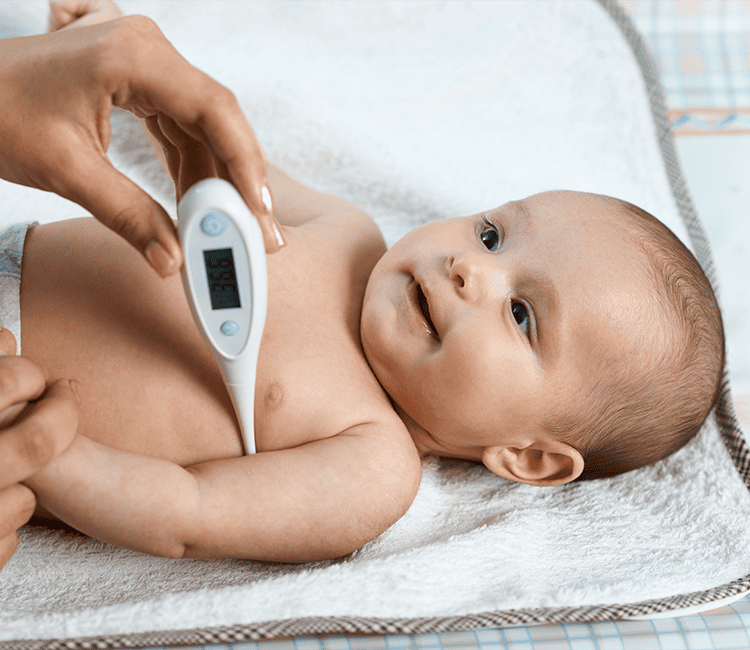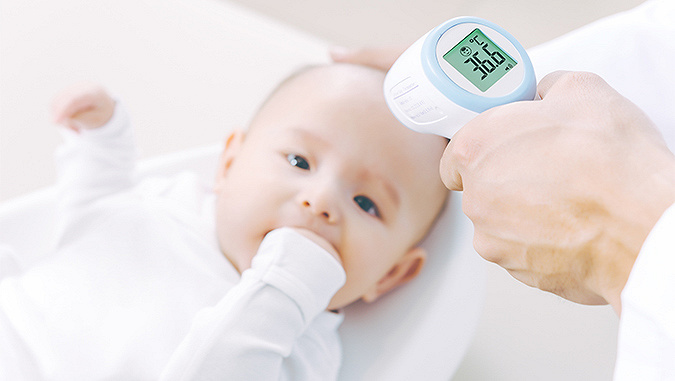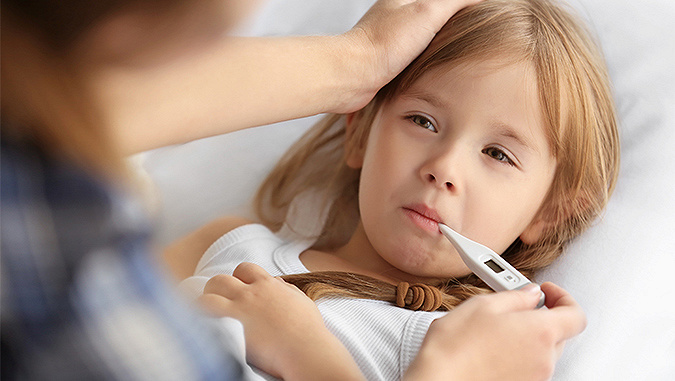Non-contact baby thermometer

During illness, it is important to make sure your baby is comfortable and feels safe. What can be done when the child has a fever? First of all, you need to monitor the temperature to know what steps to take.
Many parents remember the old thermometers well. In addition to the fact that you had to hold them under your arm for a long time to take a measurement, they also had to be handled very delicately. If broken, they were dangerous because they contained toxic mercury.
Nowadays, in the era of new technology, we do not have to worry about such things. We can choose from many types of thermometers, including the most convenient - non-contact. Are these products ideal? We will check in this article.
How does a non-contact thermometer work?
A non-contact thermometer takes an infrared measurement. What does this mean? The body emits infrared radiation. The higher the body temperature - the higher the radiation. Thanks to this technology it is possible to read the result very quickly without having to touch the baby's body.
Is a non-contact thermometer accurate?
Each technology has its own characteristics. A non-contact thermometer will not give as precise measurements as a classic mercury thermometer or an electronic thermometer (inserted under the armpit). It works on a different principle - that of measuring the course of the temperature, i.e. whether a fever is decreasing, rising or staying stable. Apart from this, many different factors influence the measurement of temperature with such a thermometer. It is important to follow a few important rules in order to obtain an accurate measurement.
What can I do to properly take my temperature without touching it?
- The temperature of the thermometer must be stable - it must lie for some time in the room where the measurement is to be taken.
- The ambient temperature must be constant - do not measure in a draughty place or where there are sudden temperature changes.
- Follow the instructions - as a rule the thermometer is designed for one type of measurement, e.g. measure the temperature on the forehead (not temples, neck etc.) and keep the indicated distance, e.g. 2 cm.
- Check the battery condition - a weak battery will affect the measurement.
- Pay attention to your skin - it should not be sweaty, oily, etc.
- Pay attention to the tip of the thermometer - it must be clean!

Is a non-contact thermometer suitable for measuring temperature in a newborn and infant?
Yes, a non-contact thermometer is ideal for taking the temperature of newborns and infants. Every parent who has tried to take the temperature of a wriggling baby with a traditional thermometer knows that... It often borders on the miraculous! And the measurement is usually inaccurate. Small babies do not yet understand that they should not move while the temperature is being taken. A non-contact thermometer is often the only solution.
Non-contact thermometer - what are its benefits?
The main and most obvious advantage is the ability to take a measurement without touching the body. No other thermometer can measure the temperature accurately when the baby moves. Keeping a baby in the same position is virtually impossible, let alone with a thermometer (in the mouth, under the armpit, in the anus).
Another advantage is the ability to take the measurement while the baby is asleep. Surely every parent will appreciate this convenience! During an illness it is very important to monitor the fever regularly. With a non-contact thermometer it is possible to measure fever during the night without waking the baby. It is very important - there is no need to put the child to sleep again, everything is done without stress. And as we know, sleep is the best medicine for all illnesses - so you should not interrupt it, but let the child stay under its soothing influence.
The undoubted advantage of such thermometers is their safety. First, unlike thermometers containing toxic mercury, they are completely harmless. Secondly, they do not come into contact with the body, so they cannot transmit any viruses or bacteria. This is possible when measuring the temperature with a classic device in several family members. Non-contact thermometers are the only ones used in hospitals and clinics, and this best proves their safety.
Modern thermometers also have additional conveniences, such as the ability to autocalibrate. Thanks to it, the device will adjust itself to the ambient temperature (this is an important factor influencing the measurement). Often these products also have the option to turn off the sound and backlighting of the screen (a great solution when the child is asleep and you do not want to wake it up). Some can also measure the temperature of the environment and, for example, bath water or milk.
Types of non-contact thermometers
Non-contact thermometers measure the intensity of heat radiation that the body emits. There are a few types of these devices:
- Radiation thermometers - monitor total body heat radiation.
- Strip thermometers - monitor certain strips of thermal radiation.
- Color thermometers - monitor a specific wavelength of radiation.
What is a temperature trend?
We wrote earlier about the fact that a non-contact thermometer will not give very precise results (compared to a classic liquid thermometer). Instead, it will monitor the so-called temperature trend. What is this? It is a progressive change in the course of a fever. That's why you measure your temperature, right? You want to know if it's already high enough to give your child medicine, or if the medicine you gave worked and the fever is going down?
So don't put so much weight on a single measurement, but relate it to subsequent ones - compare and monitor the course of the fever over time.
In exceptional cases - if the thermometer indicates a very high temperature - you can also verify it by using a thermometer, for example, in your baby's rectum.
Manual calibration of the thermometer
What is a thermometer calibration? It is the time it takes for the device to adjust to the ambient temperature. For example, you keep your thermometer in the kitchen cabinet and it is hot in there. You want to take the temperature of a baby who is lying in a cot in its room. You will not be able to do this right away. The thermometer needs some time to calibrate itself. Otherwise, the measurement will be wrong.
There are products on the market that have two types of calibration: manual and automatic. The latter is convenient in the sense that you do not have to set anything yourself. But such a thermometer needs much more time to adapt to the ambient temperature. Usually this takes about 30 minutes. You should still check if the device is really calibrated, i.e. you measure the ambient temperature and compare it with your home thermometer (if you have one).
Manual calibration is much faster - after calibrating the thermometer manually, it only takes a few seconds and it is ready to use.
Sensor for distance between thermometer and measuring surface
The instructions often tell you to hold the thermometer 2, 3 or 5 cm from your body. This is not easy to do by eye. An inaccurate measurement will result in a false reading. Therefore, it is best to choose non-contact thermometers with a distance sensor. Most often this is a projector that will tell you if the distance is correct. Sometimes there are also audible indicators.
If you want accurate results, read the instructions and follow the rules for correct measurement. When choosing a thermometer, check where it is manufactured, whether it has a warranty and features that make it easier to measure. There are a lot of cheap devices on the market with questionable quality, so choose carefully.

How do you care for your child during illness?
We already know how to monitor temperature changes. How can we take care of a baby during illness to ensure comfort? First of all, we must strictly follow the doctor's recommendations.
If the child has a fever, we can give it medicines to reduce fever containing ibuprofen or paracetamol. Applying cool compresses is also effective. Reducing the intensity of light will bring relief to the eyes.
A sore throat can be relieved by giving special syrups, infusions, lozenges, sprays etc. There are special syrups for infants; your pediatrician will certainly recommend some that fit your baby's symptoms.
Cleaning the nose is also very important. Older children usually have no problem blowing their nose. Young children cannot do this, so you need to help them remove secretions. Special nasal aspirators are used for this purpose. It is very important to make it easier for your baby to breathe at night. Some cots, such as UNO UP and NESTE UP, have a function to adjust the angle of the mattress. The child's head is higher, making it easier for him or her to breathe. A co-sleeper cot is an ideal solution when the child is ill - the parent is always close by. The child has the psychological comfort that help from mom or dad is at hand.
When a child has a fever, it usually sweats a lot. Therefore, it is extremely important to provide him or her with an adequate amount of liquids. Otherwise the baby may be at risk of dehydration. One should also remember about an appropriate diet. It should be balanced and easy to digest, so that the body has the strength to fight the infection.
A child's illness is a stressful experience for the parent as well. However, it is worth remembering that the mood of the caregiver translates into the mood of the child. Therefore, it is worth trying to stay calm. Certainly, parents and children will be calmer when they are close to each other. In the case of infants, a co-sleeper cot is an ideal solution. Parents should also get a good quality non-contact thermometer to monitor their baby's temperature without disturbing them - without waking them from sleep.
